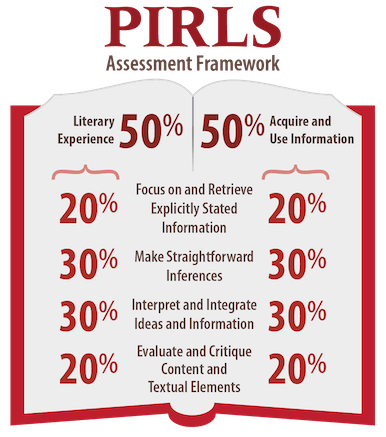PIRLS 2021 International Results in Reading
Relative Achievement in Reading Purposes and Comprehension Processes
Published as Chapter 1 in PIRLS 2021 Assessment Frameworks, the PIRLS 2021 Reading Assessment Framework provided the guidelines for developing the assessment content. Since the inception of PIRLS in 2001, the assessment framework has been organized according to two overarching purposes for reading:
- For literary experience
- To acquire and use information
As shown below, the framework also describes four cross-cutting reading comprehension processes: retrieving, straightforward inferencing, interpreting and integrating, and evaluating and critiquing. The illustration includes the targeted weights of coverage, showing that PIRLS should involve 50 percent literary texts and 50 percent informational texts as well as 20 percent, 30 percent, 30 percent, and 20 percent of the four cross-cutting reading comprehension processes.
From country to country, as a result of the curriculum or other factors, students might have relative strengths and weaknesses in reading literary compared to informational texts. The next part of this section of the report shows countries’ relative achievement in reading literary texts compared to reading informational texts in PIRLS 2021. The second part of this section presents the relative achievement results for two broad comprehension processes—1) retrieving and straightforward inferencing and 2) interpreting, integrating, and evaluating.
For information about how the subscales for the reading purposes and comprehension processes were created, see Chapter 11 in Methods and Procedures: PIRLS 2021 Technical Report. The results in the purpose and process subscales are presented to provide a more nuanced view of overall reading achievement.

The comparison between overall reading achievement and particular subscales may indicate countries’ relative strengths and weaknesses within overall reading. However, the subscales are based on only half the assessment items, making them somewhat less robust than the overall reading achievement results based on the entire scale. The subscale trend results are not reported here because they are less stable than the overall trend results and could be even further influenced by COVID-19 to an unknown degree.
